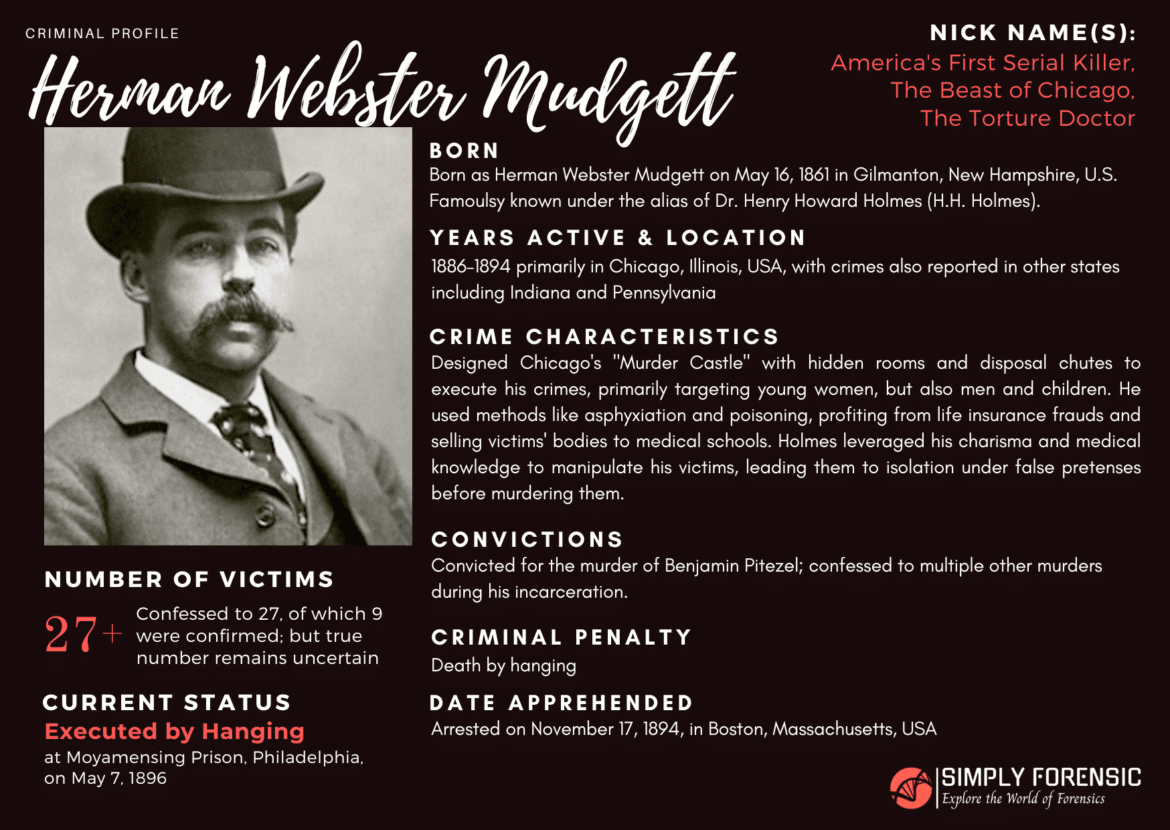Introduction to H.H. Holmes and the Murder Castle
In the grim annals of American true crime, few stories are as disturbing and haunting as that of H.H. Holmes, a man often referred to as America’s first serial killer. Operating under the alias Dr. Henry Howard Holmes, Holmes built a reputation that would terrify the nation, centering around his infamous “Murder Castle” in Chicago. This chilling tale of manipulation, greed, and cold-blooded murder has fascinated and horrified people for over a century.
- Introduction to H.H. Holmes and the Murder Castle
- Criminal Profile
- Early Life and Descent into Depravity
- Chicago and the Construction of the Infamous “Murder Castle”
- Construction and design of the Murder Castle
- Inside the Murder Castle: Secret chambers and hidden horrors
- Victims of H.H. Holmes and the Murder Castle
- The Capture and Trial of H.H. Holmes
- Sentenced to Death
- A Macabre Execution
- The Holmes Curse
- The Legacy of the Murder Castle
- Unsolved mysteries and conspiracy theories surrounding the Murder Castle
- Conclusion: A Grim Reminder of Human Depravity
Born Herman Webster Mudgett in 1861 in New Hampshire, Holmes displayed signs of manipulative behavior and a morbid fascination with death from a young age. As he grew older, these tendencies would evolve into something far more sinister, culminating in the construction of a building designed specifically to facilitate his gruesome crimes—a building that would become known as the “Murder Castle.”
This blog post delves into the dark and twisted life of H.H. Holmes, exploring his crimes, the construction of his macabre “Murder Castle,” and the lasting impact he left on American criminal history.
Criminal Profile
Holmes’s intelligence and charm allowed him to deceive many and manipulate those around him to achieve his criminal ends. His medical education aided in the dissection and disposal of bodies. Holmes exhibited classic signs of psychopathy, including a profound lack of empathy, narcissism, and possibly sadistic tendencies, as evidenced by his meticulous planning of murder methods and the elaborate construction dedicated to these activities. His crimes were financially motivated in many instances, utilizing fraud and deceit to profit from life insurance policies and the sale of cadavers.
Holmes’s case is particularly notable for its brutality and the cold, calculated manner in which he planned and executed his crimes. His “Murder Castle” is one of the most chilling aspects of his criminal career, demonstrating his engineering of an environment specifically designed for murder and body disposal, reflecting a level of premeditation and psychological detachment that is uniquely horrifying. His ability to maintain a facade of respectability and charm while committing such heinous acts is a stark reminder of the complex, dualistic nature of some criminal minds.

Early Life and Descent into Depravity
Herman Webster Mudgett, who would later assume the name H.H. Holmes, was born in Gilmanton, New Hampshire, on May 16, 1861. Raised in a strict and religious household, Holmes was often the target of bullying. One particularly traumatic incident involved being forced to touch a human skeleton, an experience that ignited a dark curiosity in young Holmes rather than instilling fear.
Holmes attended the University of Michigan Medical School, where he indulged in various macabre activities, including stealing corpses from the lab to use in insurance scams. After completing his medical degree, Holmes moved to Chicago and adopted the alias “H.H. Holmes,” beginning his career as a con artist, a pharmacist, and eventually, a serial killer.
Chicago and the Construction of the Infamous “Murder Castle”
In 1886, Holmes arrived in Chicago, a city ripe with opportunities for someone with his particular set of skills. He soon found work at a local drugstore owned by Mrs. Holton, whose husband was gravely ill. Holmes quickly ingratiated himself with the Holtons, and after the mysterious disappearance of the couple (which Holmes claimed was due to them moving away), he took over the business and acquired the lot across the street.
On this lot, Holmes began the construction of a three-story building that would later be known as the “Murder Castle.” Officially, it was a hotel designed to accommodate visitors to the upcoming 1893 World’s Columbian Exposition. Unofficially, it was a house of horrors, complete with hidden rooms, secret passageways, and a maze of hallways designed to confuse and trap his victims.
The ground floor housed various businesses, including Holmes’s drugstore, while the upper floors were reserved for his gruesome activities. Here, Holmes would select his victims—often employees, lovers, or hotel guests—subject them to unimaginable tortures, and eventually kill them. The methods of disposal ranged from dissection to cremation, with Holmes selling skeletons and organs to medical institutions.
Construction and design of the Murder Castle
The Murder Castle was a masterpiece of sinister engineering, a testament to Holmes’s twisted genius and meticulous planning. Constructed between 1888 and 1892, the building featured a labyrinth of rooms, secret passages, and hidden compartments, all designed to facilitate Holmes’s heinous crimes.
Some of the most chilling features included:
- Soundproof Rooms: Specially designed to muffle the screams of his victims.
- Gas Chambers: Rooms equipped with gas lines that could be used to asphyxiate unsuspecting individuals.
- Trap Doors and Chutes: Strategically placed to dispose of bodies, leading directly to the basement or incinerator.
- Vault and Acid Pit: A secure vault and an acid pit for the disposal of remains.
Holmes spared no expense in outfitting his macabre creation, ensuring that every detail was meticulously planned and executed.
Inside the Murder Castle: Secret chambers and hidden horrors
As visitors and employees entered the Murder Castle, they were unaware of the horrors that lurked within its walls. Holmes employed a variety of tactics to lure his victims, often offering employment opportunities or posing as a trustworthy businessman.
Once inside, the unsuspecting individuals would find themselves trapped in a nightmarish labyrinth of rooms and corridors. Holmes would employ various methods to subdue and kill his victims, ranging from strangulation and poisoning to suffocation and dismemberment.
The Murder Castle was a veritable house of horrors, with each room holding its own sinister secrets. Some of the most chilling discoveries made by investigators included:
- The Hanging Room: A room specifically designed for executions, complete with a trapdoor and noose.
- The Vault: A secure room where Holmes stored the bodies and valuables of his victims.
- The Kiln: A large kiln used to incinerate the remains of his victims, leaving no trace behind.
Victims of H.H. Holmes and the Murder Castle
Holmes’s method of operation involved seducing, swindling, and then killing his victims, who were primarily women but also included men and children. He offered jobs to young women and promised marriage to others, only to kill them and collect on their life insurance policies. The exact number of Holmes’s victims remains unknown, with estimates ranging from 20 to over 200. The Murder Castle was his playground, where he conducted horrifying anatomical experiments on his victims’ bodies.
Among the known victims were employees, guests, and even Holmes’s own wives and children. Some of the most notable victims included:
- Benjamin Pitezel: A former employee and accomplice of Holmes, who was murdered along with several members of his family.
- Julia Conner: One of Holmes’s many wives, who disappeared under mysterious circumstances.
- Pearl Conner: Holmes’s daughter with Julia Conner, who vanished without a trace.
The identities of many victims remain unknown, their names lost to history, their remains forever concealed within the walls of the Murder Castle.
The Capture and Trial of H.H. Holmes
Holmes’s reign of terror came to an end in 1894 when he was arrested in Boston for a horse theft scam. However, authorities quickly linked him to more sinister crimes, including the murders associated with the Murder Castle.
A thorough investigation of the Castle uncovered a treasure trove of evidence
During the trial, Holmes dismissed his attorneys and attempted to defend himself, but his charm and wit were not enough to sway the jury. He was found guilty of murder and sentenced to death. Despite his efforts to appeal, Holmes was executed by hanging on May 7, 1896.
Sentenced to Death
Holmes’s sentence was swift and decisive: death by hanging. Appeals to the Pennsylvania Supreme Court and pleas for gubernatorial clemency was ignored, sealing his fate. As Holmes faced his final moments, he met with two Catholic priests and took communion, yet refused to ask forgiveness for his numerous crimes, maintaining his manipulative demeanor to the end.
A Macabre Execution
Holmes’s execution was as dramatic as his trial. At the moment the trapdoor beneath him opened, a lightning bolt reportedly tore through the sky, marking his death with an eerie coincidence. However, it was the prolonged nature of his death—his heart continued to beat for nearly 15 minutes after his neck broke—that fueled rumors of a supernatural aspect to his demise.
The Holmes Curse
Holmes’s death did not put an end to the horrors associated with his name. Following his execution, several people connected to his trial and imprisonment met untimely and often mysterious deaths, leading to rumors of a “Holmes Curse.” These included a prison superintendent who died by suicide, the trial judge and head coroner who suddenly fell ill and died, and even the Pinkerton detective who had tracked him down, suffering from a sudden and severe illness.
The Legacy of the Murder Castle
The legacy of H.H. Holmes and his Murder Castle continues to fascinate and horrify to this day. The site where the Castle once stood is now an ordinary city block in Chicago, but the memory of the atrocities committed there remains. The story of H.H. Holmes has been immortalized in books, films, and documentaries, cementing his place as one of America’s most notorious serial killers.
Despite the passage of time, many questions about Holmes and his crimes remain unanswered. The true number of his victims may never be known, and conspiracy theories about hidden accomplices and undiscovered secrets continue to circulate.
Unsolved mysteries and conspiracy theories surrounding the Murder Castle
Despite the wealth of information available about H.H. Holmes and the Murder Castle, numerous mysteries and unanswered questions remain. Some of the most enduring conspiracy theories and unsolved mysteries include:
- The Missing Victims: While Holmes confessed to 27 murders, many believe the true number of victims could be much higher, with some estimates suggesting hundreds of potential victims.
- The Accomplices: Speculation persists that Holmes may have had accomplices who aided him in his crimes, though their identities remain unknown.
- The Hidden Treasure: Rumors abound that Holmes may have hidden a substantial fortune, obtained from his victims, in secret locations within the Murder Castle or elsewhere.
These lingering mysteries have fueled countless theories and investigations over the years, adding to the enduring fascination with this dark chapter in history.
Conclusion: A Grim Reminder of Human Depravity
The story of H.H. Holmes and the Murder Castle is a chilling reminder of the depths of human depravity. Holmes’s cunning, charm, and complete lack of remorse allowed him to commit some of the most heinous crimes in American history. As we remember the victims of Holmes’s monstrous actions, we are reminded of the importance of vigilance, justice, and the value of human life.
The legacy of the Murder Castle serves as a stark warning against complacency and a call to remain ever-vigilant against the forces of evil that can lurk in the shadows of society. Let us honor the memory of those who fell victim to Holmes’s cruelty by ensuring that such atrocities can never again take root.
What are your thoughts on H.H. Holmes and the dark legacy he left behind? Share your views in the comments below.











